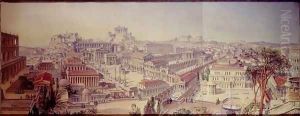Arthur Ashpitel Paintings
Arthur Ashpitel was an English architect born in the early 19th century. He was the son of the architect and surveyor William Hurst Ashpitel, from whom he likely gained his initial interest and education in architecture. Born in London on March 19, 1807, Arthur Ashpitel would go on to be recognized for his contributions to Victorian architecture, particularly in the realm of public buildings and ecclesiastical designs.
After his early education, Ashpitel began his professional training under his father and later worked in the office of John Britton, an English antiquary, author, and editor. This early exposure to the historical aspects of architecture would influence his later works, which often included elements of historical revivalism. Ashpitel became an associate of the Royal Institute of British Architects (RIBA) in 1836 and would later be elevated to the status of a fellow in 1841, reflecting his growing stature in the field.
Throughout his career, Ashpitel exhibited a great deal of versatility, designing a range of structures including churches, banks, and hospitals. One of his notable ecclesiastical projects was the Church of St John the Evangelist in Blackheath, completed in the mid-19th century. He also collaborated with John Whichcord Jr. on the design of the Wellington Testimonial in London, a project that demonstrated his ability to work on public monuments.
In addition to his architectural practice, Arthur Ashpitel was an active member of the architectural community and contributed scholarly articles to various periodicals. He was particularly interested in the history of architecture, and his knowledge in this area was well-respected by his peers. His written works covered a wide range of topics, from the drainage and sanitation of cities to the architectural styles of historical buildings.
Ashpitel's architectural style was characteristic of the Victorian era, with a blend of Gothic and Classical elements often present in his designs. His works are notable for their attention to detail and for incorporating the latest technological advancements of the time. It was this combination of historical sensitivity and modern innovation that earned him a respected place among Victorian architects.
Arthur Ashpitel's career was cut short by his premature death on January 18, 1869. Despite his relatively short life, his legacy in architecture lived on in the buildings he designed and through his written contributions to the field. Today, he is remembered as a skilled architect who played a role in shaping the architectural landscape of Victorian England.



